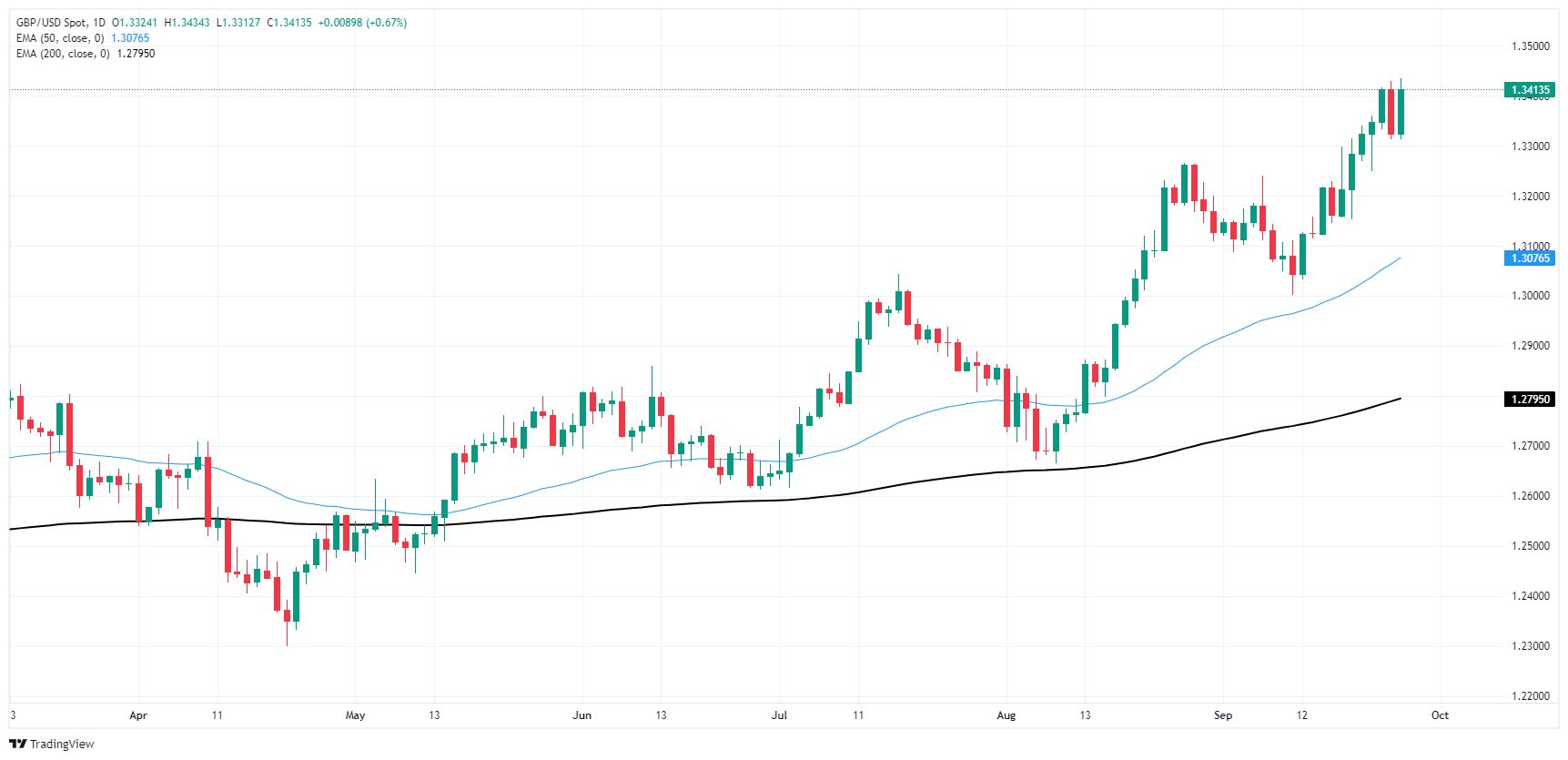GBP/USD breaches fresh 31-month high as Pound rally continues

- GBP/USD got pushed into another multi-year high on Thursday.
- Broad-market Greenback weakness has bolstered Cable further.
- The Pound Sterling rally is continuing unabated despite a lack of UK data.
GBP/USD clipped another multi-year peak on Thursday, hitting a 31-month high bid 1.3434 as Cable gets pushed into the high end by broad-market Greenback selling. Risk appetite has swung back into the high end on the back of better-than-expected US economic figures, easing investor concerns of a potential economic slowdown.
The Federal Reserve’s (Fed) recent 50 bps rate trim sparked an undercurrent of concern in global markets, with some investors spooked by the possibility that the Fed’s jumbo rate cut might have been in response to a looming economic slowdown with the US. Fed Chair Jerome Powell insisted last week that the Fed’s double cut was not a rapid response to potential recession data, but rather a pre-emptive move to help shore up the US labor market.
US Durable Goods Orders and week-on-week Initial Jobless Claims helped to bolster the Fed head’s case, with both figure printing better than expected and the “soft landing” economic rhetoric holding steady. However, Friday’s Personal Consumption Expenditure (PCE) inflation print will draw plenty of attention, and will be the real test of last week’s Fed rate cut.
US Durable Goods Orders in August printed a flat 0.0% MoM, well below the previous month’s revised 9.9%, but still beat the forecast of a 2.6% contraction. Initial Jobless Claims for the week ended September 20 also beat forecasts, printing at 218K versus the expected 225K and easing down from the previous week’s revised 222K.
GBP/USD price forecast
With Cable continuing to grind through multi-year highs, little relevant technical resistance lies in the way of Pound bulls. However, an extremely one-sided push into the high end has left GBP/USD price action exposed to a potential downside snap as market velocity takes hold. A buildup of short pressure at the current region could easily shoot bids back below the 1.3100 handle and into the 50-day Exponential Moving Average (EMA) at 1.3076.
GBP/USD daily chart
Pound Sterling FAQs
The Pound Sterling (GBP) is the oldest currency in the world (886 AD) and the official currency of the United Kingdom. It is the fourth most traded unit for foreign exchange (FX) in the world, accounting for 12% of all transactions, averaging $630 billion a day, according to 2022 data. Its key trading pairs are GBP/USD, aka ‘Cable’, which accounts for 11% of FX, GBP/JPY, or the ‘Dragon’ as it is known by traders (3%), and EUR/GBP (2%). The Pound Sterling is issued by the Bank of England (BoE).
The single most important factor influencing the value of the Pound Sterling is monetary policy decided by the Bank of England. The BoE bases its decisions on whether it has achieved its primary goal of “price stability” – a steady inflation rate of around 2%. Its primary tool for achieving this is the adjustment of interest rates. When inflation is too high, the BoE will try to rein it in by raising interest rates, making it more expensive for people and businesses to access credit. This is generally positive for GBP, as higher interest rates make the UK a more attractive place for global investors to park their money. When inflation falls too low it is a sign economic growth is slowing. In this scenario, the BoE will consider lowering interest rates to cheapen credit so businesses will borrow more to invest in growth-generating projects.
Data releases gauge the health of the economy and can impact the value of the Pound Sterling. Indicators such as GDP, Manufacturing and Services PMIs, and employment can all influence the direction of the GBP. A strong economy is good for Sterling. Not only does it attract more foreign investment but it may encourage the BoE to put up interest rates, which will directly strengthen GBP. Otherwise, if economic data is weak, the Pound Sterling is likely to fall.
Another significant data release for the Pound Sterling is the Trade Balance. This indicator measures the difference between what a country earns from its exports and what it spends on imports over a given period. If a country produces highly sought-after exports, its currency will benefit purely from the extra demand created from foreign buyers seeking to purchase these goods. Therefore, a positive net Trade Balance strengthens a currency and vice versa for a negative balance.
